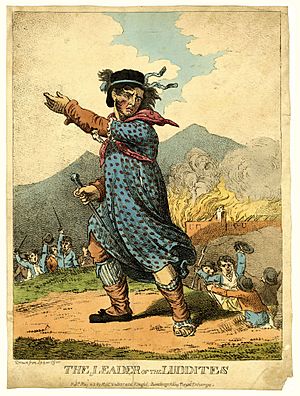Luddite facts for kids
The Luddites were a group of English textile workers in the early 1800s. They protested against new machines that were changing their jobs. These workers feared that machines would take away their skills and their livelihoods. They believed the machines were used in a "deceitful" way to avoid fair work practices.
The Luddite movement started in Nottingham, England. It grew into a large protest across the region between 1811 and 1816. Factory owners sometimes shot at the protesters. The government eventually used military force to stop the movement.
Over time, the word "Luddite" has come to mean someone who is against new technologies or automation. However, the original Luddites were not against machines themselves. They were against how these machines were used to harm their way of life and their jobs.
Contents
What Were the Luddites?
The Luddites were skilled workers, mostly in the textile industry. They made cloth using traditional methods. When new machines like power looms arrived, these machines could do the work much faster. This made the Luddites worried about their future.
- They feared losing their jobs.
- They worried their skills would become useless.
- They felt the new machines were unfair.
These workers took an oath (a serious promise) to resist the new machinery. They often destroyed machines as a way to protest.
Why Did They Protest?
The Luddites were not just against progress. They were protesting against changes that threatened their families and their way of life. They saw the machines as a threat to their ability to earn a living.
- Machines could make cloth cheaper and faster.
- This meant less demand for skilled hand-workers.
- Wages for human workers often went down.
The Luddites wanted fair treatment and to protect their traditional jobs. They believed the new factory system was unfair to workers.
Where Did the Movement Happen?
The Luddite movement began in the English city of Nottingham. It then spread to other areas known for textile production. These included parts of Yorkshire, Lancashire, and Cheshire.
- The protests often happened at night.
- Workers would break into factories.
- They would smash the new machines.
The government saw these actions as a serious threat. They sent soldiers to control the protests.
How Did the Luddite Movement End?
The British government took strong action against the Luddites. They passed laws that made destroying machines a crime punishable by death. Many Luddites were arrested, put on trial, and some were even executed.
- The military was used to stop the protests.
- Many Luddite leaders were caught.
- The movement slowly died out by 1816.
Even though the Luddite movement ended, it showed the struggles workers faced during the Industrial Revolution. It highlighted how new technologies can change society and jobs.
Luddites and Today's World
Today, the term "Luddite" is sometimes used to describe someone who dislikes or avoids new technology. However, the original Luddites were fighting for their livelihoods and fair working conditions.
- They were not against all machines.
- They were against machines that harmed their jobs.
- Their protests were about fairness and survival.
The Luddite story reminds us to think about how new technologies affect people's lives and jobs.
See also
 In Spanish: Ludismo para niños
In Spanish: Ludismo para niños 


